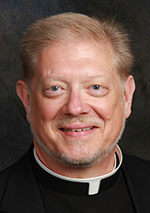That All May Be One / Fr. Rick Ginther
The connections of Passover to our observance of Holy Week
 When I was growing up, Art Linkletter had a delightful TV show, “Kids Say the Darnedest Things.”
When I was growing up, Art Linkletter had a delightful TV show, “Kids Say the Darnedest Things.”
And the title of the show remains true to this day. Kids often leave parents and elders shaking their heads, holding their sides, wondering how to respond appropriately!
Some things that kids say are quite serious. They lead to moments of thought, discussion and prayer.
“Why is this night different from all other nights?” asks a child.
The sun has set on 14 Nisan. It is now 15 Nisan in the Jewish calendar. The days of Passover have begun. A child, often the youngest, has spoken the question.
This meal is unique among Jewish meals. The finest china and silverware are brought out. The food to be eaten and the four cups of wine to be drunk are prepared. The family reclines—if possible—to share the meal.
The feast is highly organized. “Seder” reflects this. The word is derived from the Hebrew word for “order” or “arrangement.”
The meal is divided into 15 parts. Tradition has it that these parts “parallel” the 15 steps of the Temple in Jerusalem on which the Levites stood during Temple services. These same steps are remembered in the “Psalms of Ascent”—Psalms 120-134.
The Seder meal commemorates the Hebrew people fleeing from Egypt. A special text called the “Haggadah” is used to retell the story. All observant Jews are called upon to celebrate the Seder meal with their families and friends each year (Ex 12:14, Dt 16:12).
The children present play an integral part. From an early age their eyes, ears and minds are filled with the uniqueness of the night—the food eaten, the words spoken, the psalms sung and the deep meanings of the entire ritual.
Altogether, five questions are asked by a child/children. After the first question as to why this night is different, there follow questions that seek the meaning of the differences of this night: the food (unleavened bread, bitter herbs, the twice dipping of food) and reclining to eat.
All listen to the sacred texts. Comments and insights of meaning follow. For their participation, the children are rewarded with nuts and other sweets.
And all await the finding by a child of the “hidden” piece of unleavened bread (matzo). Of course, there is a reward for the finder!
The 14th part of this festive meal is the reciting of the “Hallel,” Psalms 113‑118. (For Christians, each of these psalms begin with “alleluia,” a Greek version of the Hebrew “hallel.”)
The days of Passover conclude with a full Jewish holiday, Shvi’i shel Pesach, or “seventh day of Passover.” Special prayer services and festive meals commemorate the miracles at the Red Sea.
There are so many connections of Passover to our Christian observances of Holy Week!
Holy Thursday Mass of the Lord’s Supper is rooted in the Seder meal tradition. And like the Seder, it is a “living memorial” in which we participate.
Good Friday, according to John’s Gospel, was the time for the slaughtering of the paschal lambs, the time of the death of the Lord—the Lamb of God—on the cross.
At Easter, we refer to the Easter candle as the “Paschal candle,” another allusion to Pesach meal and the lamb. And we renew the moment of our “passing through the waters” at our baptism.
Out of the mouths of children (babes), innocence leads to awe. Let us pray for our Jewish brothers and sisters this year (on April 8-16) even as we celebrate Holy Week and the Great Three Days (on April 5-12).
(Father Rick Ginther is director of the archdiocesan Office of Ecumenism and Interreligious Affairs. He is also the pastor of Our Lady of Lourdes Parish, Indianapolis.) †
 When I was growing up, Art Linkletter had a delightful TV show, “Kids Say the Darnedest Things.”
When I was growing up, Art Linkletter had a delightful TV show, “Kids Say the Darnedest Things.”